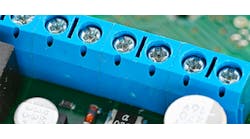Supply-chain issues have made flexibility increasingly important. OEMs who were loyal to a specific controller brand and protocol are open to looking at alternatives, if it means they can continue to ship their machines without interruption.
Communication-agnostic products are capable of speaking EtherNet/IP, Profinet, EtherCAT, Powerlink, Modbus and other protocols, giving OEMs the option to build different machines on different protocols.
Historically, drive platforms were designed to control one type of motor. You’d have a line of VFDs which only controlled induction motors. You’d have to switch to a servo drive if you wanted to control a servo motor. Flexible drives can be switched to run different motor types—induction, ac permanent magnet, linear motors.
In previous generations, different encoder formats required different encoder cards, where a user had to swap out boards. Dual-channel encoders can support more than 10 different protocols from one SKU.
Increasingly, OEMs also are looking to the drives to integrate SIL3-rated functional safety into products. Safety protocols, such as failsafe over EtherCAT (FSoE) and a ProfiSafe option, need to be integrated. Utilizing these technologies can simplify machines by requiring less discrete wiring.
Q: With supply-chain issues still causing shortages, flexibility has become increasingly important. OEMs who were loyal to a specific controller brand and protocol are now open to looking at alternatives, if it means they can continue to ship their machines without interruption. How important is it for devices to be protocol-agnostic when it comes to communicating, and what steps has KEB taken to ensure this?
Sales and marketing manager,
KEB America
A: This is a unique and interesting time in the automation world, and it will be with us for some time. North American customers have come to expect that components are stocked on the shelf. We have heard from customers that some vendors are quoting products over a year out. In some cases, they are not committing to a date. It is extremely difficult to plan a manufacturing business around this unprecedented supply-chain disruption.
Traditionally, many OEMs have been loyal to one vendor, even though there are advantages, such as performance and cost, to go with other providers. That deep-rooted relationship is changing. OEMs have begun to view single source as a business risk, not an advantage. As a result, they have become more open and more flexible in the brand and products that they source to keep up with demand, ship products in a timely manner and keep cash flowing.
One of the impediments to swapping out automation products is the communication protocol used. Some vendors only support one protocol, which effectively locks the design into that vendor or ecosystem. It doesn’t have to be this way. In the past five to 10 years, there have been advancements in the communication chips used in automation products. These chips now support many different protocols. For example, KEB’s S6 Servo Drive uses these chips and supports EtherNet/IP, Profinet, EtherCAT, Powerlink, and Modbus from common hardware. This gives our OEM customers much more flexibility in their designs.
Q: In addition to the supply troubles, are you seeing any trend among OEMs looking to consolidate and simplify design and planning by reducing the number of component SKUs for production machines and support?
A: Absolutely. This started before the supply chain crunch. In addition to upfront component costs, OEMs are increasingly looking at the total lifetime cost. This includes procurement costs, service/support costs and redesign/obsoletion costs. When possible, it is much easier and cost-effective to plan for one component SKU than 10.
In a recent example, an OEM had a machine that used two different servo motors. The company decided to upsize the smallest servo drive so it could standardize and source one SKU. The company found more value in reducing SKUs than the small investment to move up in drive rating.
There are other ways engineers can reduce automation component SKUs. The previously mentioned flexible communication protocols allow drives to be re-used across machines and end-user specifications. KEB’s S6 Servo Drive accepts input voltages from 200 to 500 Vac. This allows one drive to be used on both 208 V and 480 V installations. Traditionally, this would have required two different drive classes.
Q: Historically, drive platforms were designed to control one type of motor—for example, a line of variable-frequency drives that only controlled induction motors. What advancements have been made in controlling different motor types with one drive platform?
A: Many of our OEM customers take the approach of using the "best motor for the job." This means a machine might mix motor technologies. For example, a packaging-machine OEM primarily uses ac permanent-magnet servo motors for its machines but also uses induction motors for basic conveyors. Historically, two separate drives platforms were needed to run these motors. Possibly, the drives would even program differently.
For more than 20 years, KEB drives have the flexibility to run different motor types—induction, SPSM, IPSM, linear motor. Current drive ratings are a factor in sizing, as servos typically need higher peak currents. A simple software parameter change notifies the KEB drive to use a different motor model. As a result, OEMs can standardize on one drive platform, reducing costs and support burden.
Q: Each encoder format traditionally has required its own encoder card, which meant a user had to swap out boards every time the encoder format needed to be changed. What progress has been made in this area to support multiple protocols?
A: Different encoder feedback formats offer yet another variable for OEMs to plan for, especially if they are using different motor technologies. It is quite common for machines to use a mix of TTL, Resolver, and absolute (Hiperface/BiSS/EnDat) formats. Each format uses its own voltage levels and signals.
KEB used to support these formats with separate encoder cards. This led to many drive variants. It was not very flexible once the drive shipped to the field.
Today, the KEB S6 and F6 VFD products use a dual-channel high-density feedback input that supports 10 different feedback formats. OEMs can source the correct feedback cable with the appropriate pinout. This is another way a single drive platform offers flexibility in its implementation.
Q: No machine-building conversation is complete without addressing safety. How much are you hearing OEMs asking for functional safety in components? What SIL is most common, and is there any movement toward integrating safety protocols?
A: Functional safety at the drive level is paramount. KEB drives used to include STO as an add-on option, but this feature is now a standard.
Our newer drives feature scalable functional safety (SIL3/Ple), and Safe Motion functions like Safe Limited Speed (SLS) and Safe Direction (SDI).
The transmission of safety signals, such as STO, over a communication network decreases discrete wiring and wiring time. This is most beneficial for multi-axis machines. KEB drives include protocols that are certified to SIL3/PLe, like FailSafe over EtherCAT (FSoE) and soon-to-be released ProfiSafe.
For more information, visit www.kebamerica.com.




